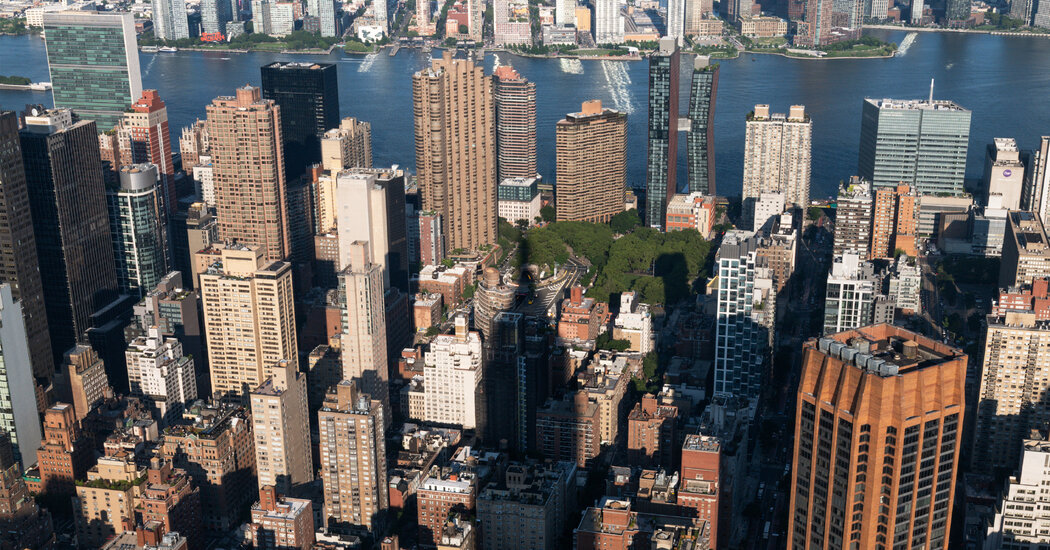As the heat index pushed 105 degrees Fahrenheit one weekend in late June, my toddler and I were on foot, searching for a cool oasis. We found one in the wide, pale shadow cast by a 26-story apartment building on the Lower East Side, on a courtyard filled with the sounds of slapping dominoes and children on scooters, zooming around playground equipment.
Although New York and other American cities badly need more shady spaces like this, it’s far too difficult to create them. Planning codes discourage new high-rises in many neighborhoods, and urban designers claim their thousand-foot shadows make the open spaces around them less inviting. But the opposite is true on extremely hot days: The monolithic shade of buildings can actually enhance parks, playgrounds and plazas by cooling them down. As extreme heat becomes more common, urban dwellers need to relinquish their bias against daytime darkness and embrace the shadows.
According to Kelly Turner, an urban planning professor at the University of California, Los Angeles, and the former director of the recently axed Center for Heat Resilient Communities, which was funded by the National Oceanic and Atmospheric Administration, shade of any kind can shave 30 percent off the heat burden, or the total heat we gain outside, as well as ward off dehydration, headaches and serious heat illnesses. Too many tall buildings can trap heat and raise air temperatures, especially overnight — a phenomenon known as the urban heat island effect. But Dr. Turner told me that during the day, warming, at least at the local level, is offset by the cooling shade.
Yet it’s harder to find built shade, as she and other researchers call the shadows cast by buildings and other man-made structures. In June, Dr. Turner and other U.C.L.A. researchers released a national shade map of over 360 American cities and towns that shows most shade is cast by trees, not walls.
Partly, this is a function of where the sun is. The researchers mapped shade coverage on the first day of summer, when the sun is highest in the sky, and found that only in the early evening, when the sun is setting, does the gray shade of buildings rival the green shade of trees that time of year. Fortunately, as summer rolls on, and average temperatures continue to rise, the shadows grow longer at all times of day.
But our limited built shade is also by design. For over a century, American planners have worked hard to preserve urban sunlight. Starting in the 1800s, reformers pushed to carve air shafts and windows into New York’s densely crowded tenements, believing the light and fresh air could help eradicate diseases like tuberculosis. Urban planners borrowed those arguments to control the density of commercial and residential districts, conducting detailed shadow studies to demonstrate that low height and deep street setbacks were needed to have access to the beneficial rays. Today, shadow avoidance is a basic tenet of American urban design.
Some cities — such as Boston and San Francisco — have rules that specifically restrict the construction of buildings that would cast shadows on public parks or playgrounds, alleging the gloom suppresses their use. New York adopted zoning codes in the 1970s to encourage maximum sunlight in plazas. And some developers are required to submit studies to city agencies if their buildings’ shadows could encroach on open spaces and other sunlight-sensitive public resources.
The disclosure of those shadows can trigger public backlash. Famously, two planned Columbus Circle skyscrapers were shelved after a 1987 protest mimicked the long winter shadows they would throw across Central Park. (The building complex, now known as the Deutsche Bank Center, was eventually built in scaled-back form.) On the Upper East Side, a proposed 16-story office tower that would darken a park across the street is on indefinite hold, and a 68-story mixed-use building project in East Harlem has been sued into oblivion because it would transform an adjacent soccer field into what a neighbor called “the bottom of an elevator shaft.”
Of course, when many of New York’s zoning codes were written, global warming was not a consideration. But in the near future, the city could face roughly two months of 90-degree heat every year. Heat could similarly grow more intense across much of the rest of the country. Although that weather will endanger everyone spending significant time outside, it will pose a particular threat to children, older people, pregnant women, people with chronic health conditions and outdoor workers.
Studies show that shade can help. When the air temperature is about 95 degrees and the humidity is around 60 percent, a sunny park is dangerous for healthy older adults, according to an international team of heat experts. Yet it should be perfectly safe for them to sit on a bench in shade.
Planners need to use data like this to show how effective shade can be. They also need better maps, like the one Dr. Turner and her colleagues at U.C.L.A. have produced in partnership with the nonprofit American Forests, to show where shade is lacking and where it’s more plentiful. That information could be especially valuable to transportation planners who want to reroute bike paths through cooler corridors or move bus stops to shadier streets.
In neighborhoods where tall buildings are banned, we need to plant more trees, which block the sun and cool the air. Few oppose their leafy shade. But in the long run, the public needs to get over its fear of more permanent shadows.
Yes, it’s a shame when a new tower darkens our backyard garden or obscures our view. But if we can learn to see what these new developments add to our cities, rather than just what they take away, we may be more accepting of shadows as a form of urban cooling.
In fact, that exact dynamic is playing out right now near Lands End II, the building complex that created the oasis for my son and me — in the form of four new skyscrapers, ranging from 62 to 80 stories tall, that would loom over the older towers. It’s not hard to imagine how those glassy, mostly market-rate developments could spur higher costs that could displace long-term residents. Some have already sued, many times, to stop them. But on a sweltering summer afternoon, as I pass by empty basketball and handball courts and abandoned playground slides, I can also imagine how their sweeping shadows could be an improvement.
Sam Bloch is the author of the forthcoming book “Shade: The Promise of a Forgotten Natural Resource.”
The Times is committed to publishing a diversity of letters to the editor. We’d like to hear what you think about this or any of our articles. Here are some tips. And here’s our email: [email protected].
Follow the New York Times Opinion section on Facebook, Instagram, TikTok, Bluesky, WhatsApp and Threads.
The post In a Hotter World, We Need to Get Over Our Fear of Shadows appeared first on New York Times.




